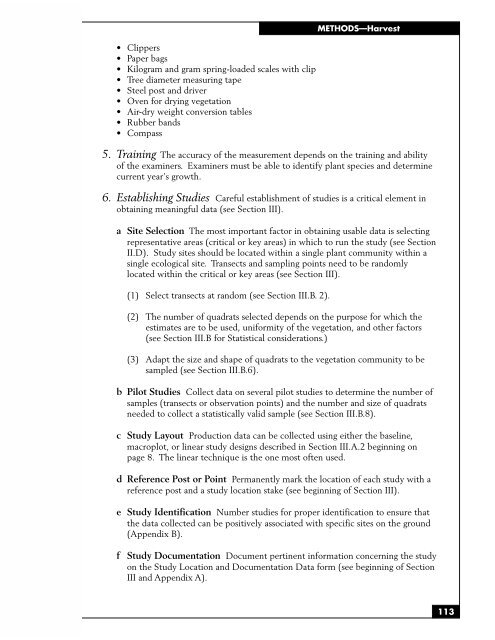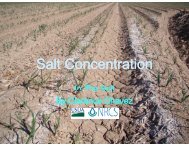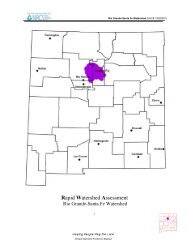SAMPLING VEGETATION ATTRIBUTES - New Mexico NRCS - US ...
SAMPLING VEGETATION ATTRIBUTES - New Mexico NRCS - US ...
SAMPLING VEGETATION ATTRIBUTES - New Mexico NRCS - US ...
Create successful ePaper yourself
Turn your PDF publications into a flip-book with our unique Google optimized e-Paper software.
• Clippers<br />
• Paper bags<br />
• Kilogram and gram spring-loaded scales with clip<br />
• Tree diameter measuring tape<br />
• Steel post and driver<br />
• Oven for drying vegetation<br />
• Air-dry weight conversion tables<br />
• Rubber bands<br />
• Compass<br />
METHODS—Harvest<br />
5. Training The accuracy of the measurement depends on the training and ability<br />
of the examiners. Examiners must be able to identify plant species and determine<br />
current year’s growth.<br />
6. Establishing Studies Careful establishment of studies is a critical element in<br />
obtaining meaningful data (see Section III).<br />
a Site Selection The most important factor in obtaining usable data is selecting<br />
representative areas (critical or key areas) in which to run the study (see Section<br />
II.D). Study sites should be located within a single plant community within a<br />
single ecological site. Transects and sampling points need to be randomly<br />
located within the critical or key areas (see Section III).<br />
(1) Select transects at random (see Section III.B. 2).<br />
(2) The number of quadrats selected depends on the purpose for which the<br />
estimates are to be used, uniformity of the vegetation, and other factors<br />
(see Section III.B for Statistical considerations.)<br />
(3) Adapt the size and shape of quadrats to the vegetation community to be<br />
sampled (see Section III.B.6).<br />
b Pilot Studies Collect data on several pilot studies to determine the number of<br />
samples (transects or observation points) and the number and size of quadrats<br />
needed to collect a statistically valid sample (see Section III.B.8).<br />
c Study Layout Production data can be collected using either the baseline,<br />
macroplot, or linear study designs described in Section III.A.2 beginning on<br />
page 8. The linear technique is the one most often used.<br />
d Reference Post or Point Permanently mark the location of each study with a<br />
reference post and a study location stake (see beginning of Section III).<br />
e Study Identification Number studies for proper identification to ensure that<br />
the data collected can be positively associated with specific sites on the ground<br />
(Appendix B).<br />
f Study Documentation Document pertinent information concerning the study<br />
on the Study Location and Documentation Data form (see beginning of Section<br />
III and Appendix A).<br />
113




